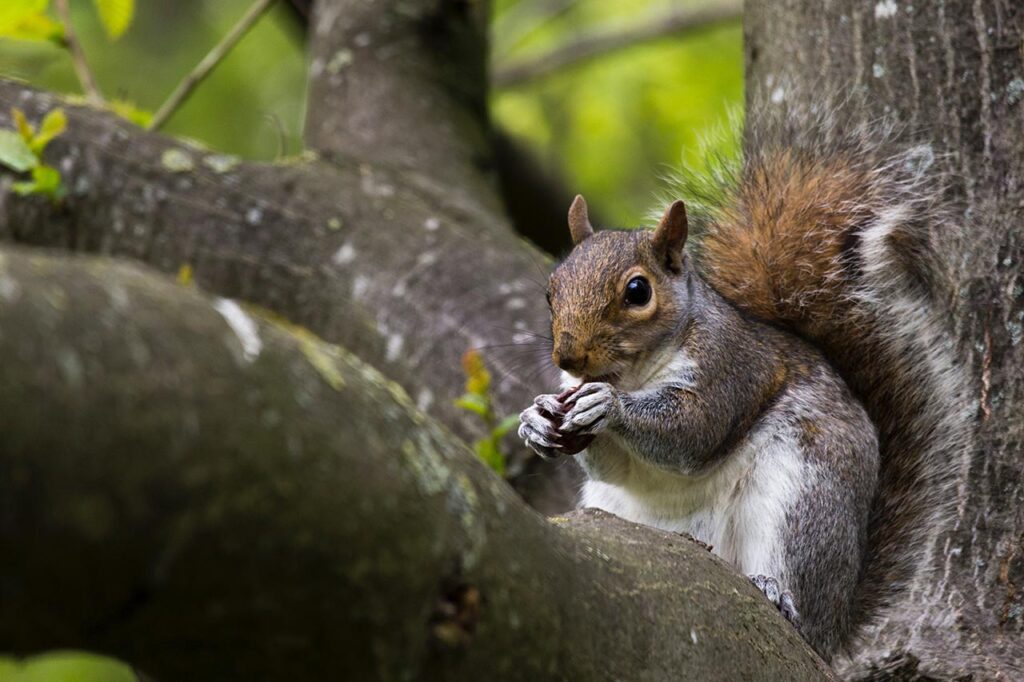Squirrel Facts
There are over 200 species of squirrels in the world. Most species are herbivores that eat nuts, fruits, and tree buds. They will sometimes eat insects, bird eggs, and carrion. Gray squirrels bury nuts all over the place. Sometimes they forget where they buried the nut and it will become a tree.

Gray, red, and fox squirrels are active during the day and flying squirrels are active at night. Red squirrels are known for being very territorial and prefer to live by themselves, where other squirrels live in groups, or with other animals in your attic. Flying squirrels are very social, living in groups of 15 or more.
Squirrels can jump as high as 20 feet and run as fast as 20 miles per hour. Squirrels are always gnawing on things because their teeth never stop growing.
Squirrel Damage
Squirrels can wreak havoc on your home and property. They can get into your house by using overhanging branches, utility lines or simply climbing up the side of the house. These rascally rodents will chew holes in your vents, eaves and roofline and scratch up your siding. They will tear apart insulation to make nests. The nests may sometimes block a vent, creating a fire hazard. Another fire hazard comes from the squirrel’s tendency to gnaw on wires. They can also damage insulation and household products with their droppings and urine.
In the yard, squirrels will take advantage of bird feeders, eating the seeds and damaging the feeder. They can also cause a mess in the garden, gobbling down flower bulbs, fruit, and freshly planted vegetable seeds. They will sometimes even chew up the bark of fruit and cedar trees.
Squirrels can expose people to some health concerns like cat scratch fever, mange, typhus, and, very rarely, rabies.
Squirrel Infestation
During mating season, squirrels will chase each other around in your attic or walls, so you might hear a chucking noise. Sounds of chewing, scampering, and scratching are all common sounds you might hear. Look for their droppings around your home where they can enter and exit your siding.
Many squirrels, like the gray squirrel use gnawed sticks, nuts, discarded shells, and nipped twigs to form their nests. Because squirrels are opportunistic feeders, your gardens and crops are in danger of being eaten. A squirrel will eat anything it can get its hands on. Other signs of an infestation include tunnels in your insulation, claw marks on siding, or damage to stored goods caused by their urine or feces.
Types of Squirrels
Squirrel Identification
Gray Squirrel
Gray Squirrels measure between 18 and 20 inches long. Despite their name, they have gray, white, or even black bodies. These pests are very social animals and will live in groups, even with other animals.
Red Squirrel
Red Squirrels measure about 12 inches long with reddish fur. The pests have flatter tails in comparison to other squirrels. They are excellent climbers and extremely territorial. They usually live by themselves. If other animals try to move into their space, they will fight them off.
Flying Squirrel
There are two main species of Flying Squirrels. The Northern variety is slightly smaller at 10 inches long. Both them and the Southern species have grayish brown fur. Unlike most squirrels, they are nocturnal and are mostly active at night.
Squirrels in the Attic & Home
Does it sound like a circus in your attic or walls? Do you hear chattering, scampering, scratching, and gnawing? Are you finding piles of acorn shells or chewed hickory nuts in the attic or house? Have you seen squirrels in your yard? Then there is a good chance that they have moved into your house. Squirrels may decide to take up residence in your home any time during the year. In the fall and winter they are looking for a place to build nests and stay warm during the winter. In the early spring squirrels look for a safe area to raise their young.
Frequently Asked Questions
What do squirrel droppings look like?
Squirrel droppings vary in size, depending on the species, but most are very similar. They can also be misidentified for rat droppings. The biggest difference — squirrel feces are more rounded on the ends, while rat droppings are tapered. They are dark-brown if fresh, and light brown if dried up.
How do I get rid of squirrels from my home?
We know you don’t want squirrels sharing your home. Even though they’re cute, don’t feed squirrels. Bird feeders also attract squirrels so if you have one, make sure it’s installed far away from your house. Feed your pets indoors, trim back tree branches that hang over the house, and seal-up any gaps where utility lines and pipes enter your house with caulk. Check to make sure siding joints and eaves are sealed too.
Screen gutters and other drainage pipes, install chimney caps, and seal any openings in the flashing. To protect your garden and freshly planted bulbs, install wire mesh and poultry wire around the perimeter.
What are the benefits of professional squirrel pest control?
Expert pest specialists have the educational background, equipment, and skill to control and remove wildlife nuisances from a property in a safe, efficient way.
If you’re struggling with squirrels on your property, contact us. Our technicians can remove the rodents and help you regain control of your property and sanity.


